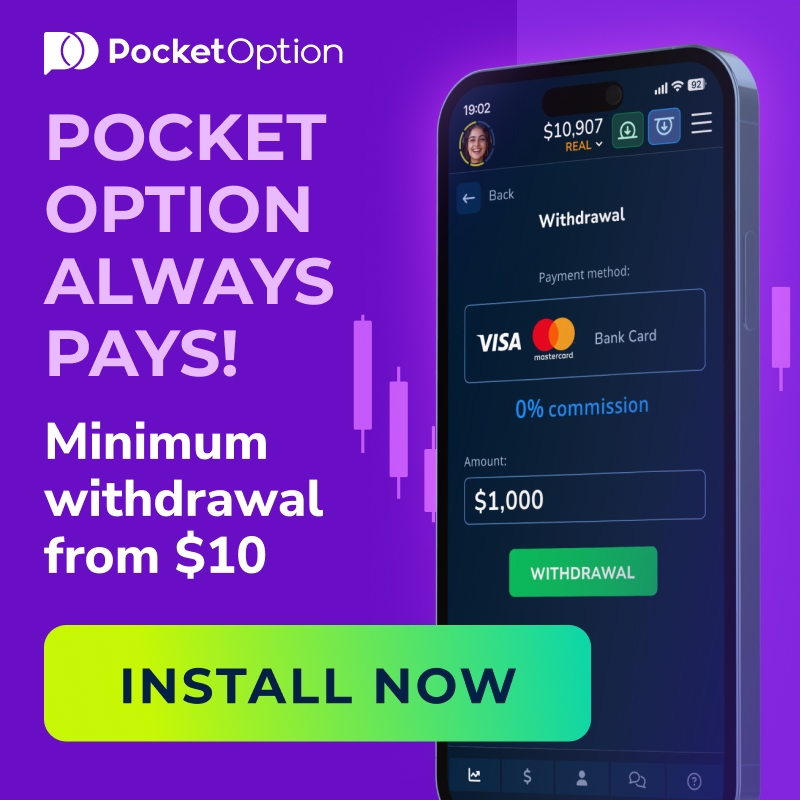
8 minute read
Pocket Option vs HFM: Which Broker Is Right for You?
from Pocket Option
Choosing the right broker is crucial for traders, whether you're a beginner or a seasoned professional. Pocket Option vs HFM (HF Markets) are two popular platforms, but they cater to different trading styles and preferences. Pocket Option is known for its beginner-friendly interface and binary options trading, while HFM excels in forex and CFD trading with robust tools and regulation.
This article compares Pocket Option and HFM across key factors—regulation, trading platforms, account types, fees, and more—to help you decide which broker suits your needs.

💥 Trade with Pocket Option now: Open An Account or Visit Brokers 👈
Overview of Pocket Option and HFM
Pocket Option is a binary options and forex trading platform launched in 2017 by Gembell Limited, based in the Marshall Islands. It’s popular for its low entry barriers, with a minimum deposit of $5 and a user-friendly interface. Pocket Option appeals to beginners and short-term traders, offering quick trades, social trading, and a demo account.
However, its regulation by the IFMRRC (International Financial Market Relations Regulation Center) is less stringent than top-tier authorities, raising concerns for some traders.
HFM (HF Markets), formerly HotForex, is a well-established global broker founded in 2010. It specializes in forex, CFDs, and commodities, offering over 1,000 trading instruments. Regulated by top-tier authorities like the FCA (UK) and CySEC (Cyprus), HFM is a trusted choice for traders prioritizing security.
Its advanced MetaTrader platforms and comprehensive tools make it ideal for both novice and professional traders.
Regulation and Safety
Regulation is a critical factor when choosing a broker. A regulated broker ensures your funds are protected and operations are transparent.
Pocket Option: Regulated by the IFMRRC, an independent body, but this is not a government-backed regulator like the FCA or ASIC. The lack of top-tier regulation raises concerns about fund security, especially after reports of withdrawal issues and frozen accounts. Some traders have faced delays or restrictions when withdrawing large sums, which can be a red flag for cautious investors.
HFM: HFM is highly regulated by multiple authorities, including the FCA (UK), CySEC (EU), and FSCA (South Africa), with a Trust Score of 86/99. These regulators enforce strict rules, such as segregated client funds and regular audits, ensuring a safer trading environment. HFM’s transparency and compliance make it a more reliable choice for traders concerned about security.
Verdict: HFM is the clear winner for safety due to its top-tier regulation and strong track record. Pocket Option’s lack of robust oversight makes it riskier, especially for large investments.
Trading Platforms and Tools
The trading platform is your gateway to the markets, so usability and features matter.
Pocket Option: Offers a proprietary web-based platform and mobile app, plus MetaTrader 5 (MT5) for forex trading. The platform is intuitive, with real-time charting, social trading, and copy trading features, making it ideal for beginners. However, advanced traders may find the tools limited for complex strategies, as the platform focuses on short-term binary options trades (30 seconds to 5 minutes).
HFM: Supports MetaTrader 4 (MT4), MetaTrader 5 (MT5), and its proprietary HFM App. These platforms are industry standards, offering advanced charting, automated trading via Expert Advisors (EAs), and tools like Autochartist for market analysis. The HFM App is highly customizable, with features like one-click trading and an economic calendar, catering to both beginners and professionals.
Verdict: HFM offers more robust and versatile platforms, especially for traders who rely on advanced tools and automation. Pocket Option’s platform is simpler but better suited for quick, beginner-friendly trades.
Account Types and Minimum Deposits
Your trading goals and budget will influence which account type is best for you.
Pocket Option: Offers seven account types, starting with a “Novice” account requiring just a $5 minimum deposit. Higher-tier accounts (e.g., Experienced, Master) unlock additional features like lotteries and express orders but require balances up to $1,000. The low entry point makes Pocket Option accessible for new traders or those testing strategies with minimal risk.
HFM: Provides six standard accounts (Cent, Zero, Pro, Premium, Pro Plus, Top-Up Bonus) and a copy trading account (HFcopy). The Cent, Zero, and Premium accounts have no minimum deposit, while the Pro account requires $100. HFM’s accounts cater to various trading styles, with options for low-cost trading, raw spreads, or swap-free Islamic accounts.
Verdict: Pocket Option has a lower entry point ($5 vs. $100 for HFM’s Pro account), making it ideal for beginners with limited capital. However, HFM’s diverse account options suit a wider range of traders, from novices to professionals.

💥 Trade with Pocket Option now: Open An Account or Visit Brokers 👈
Fees and Spreads
Trading costs can significantly impact your profitability.
Pocket Option: Does not charge internal fees for deposits or withdrawals, but third-party providers may apply charges. Binary options trading offers high payouts (up to 95%), but the all-or-nothing nature of binary trades carries high risk. Spreads for forex trading are not well-documented, and the lack of transparency raises concerns.
HFM: Offers competitive spreads, especially on its Zero account, though spreads on spread-only accounts are slightly above the industry average. HFM charges no deposit or withdrawal fees, and most transactions are processed quickly (within 24 hours for e-wallets). The broker’s transparency in fee structures and low-cost options make it appealing for cost-conscious traders.
Verdict: HFM provides clearer fee structures and competitive spreads, making it more cost-effective for forex and CFD trading. Pocket Option’s high-risk binary options may yield high returns but lack fee transparency.
Asset Selection
The variety of tradable assets determines your ability to diversify your portfolio.
Pocket Option: Offers over 100 assets, including forex, cryptocurrencies, commodities, and stocks. Its focus on binary options allows traders to speculate on short-term price movements, but the asset range is narrower compared to multi-asset brokers.
HFM: Provides nearly 1,000 CFDs, including 100+ forex pairs, stocks, commodities, indices, and cryptocurrencies. This extensive selection allows traders to diversify across multiple markets, making HFM suitable for those seeking broader investment opportunities.
Verdict: HFM’s vast asset selection outshines Pocket Option, which is more limited and focused on binary options.
Deposits and Withdrawals
Fast and reliable funding options are essential for a seamless trading experience.
Pocket Option: Supports multiple payment methods, including bank transfers, credit/debit cards, cryptocurrencies, and e-wallets. The minimum withdrawal is $10, with processing times averaging 1–3 days. However, some users report delays or issues with large withdrawals, particularly due to verification disputes.
HFM: Offers a wide range of payment methods, including local bank transfers, cards, and digital wallets, with no internal fees. Deposits are instant or within 10 minutes, while withdrawals take 1–10 days depending on the method. HFM’s fast processing and transparency make it a reliable choice.
Verdict: HFM’s efficient and fee-free funding process gives it an edge over Pocket Option, which has faced criticism for withdrawal delays.
Customer Support and Education
Quality support and educational resources can enhance your trading experience.
Pocket Option: Provides 24/7 customer support via chat, email, and phone. Users praise the responsive support team, but some report issues with complex queries. Educational resources include blog articles and basic video lessons, though they lack depth for advanced traders.
HFM: Offers 24/5 support with knowledgeable account managers and fast response times. Its educational resources are extensive, including webinars, e-books, and market analysis, catering to all skill levels. HFM’s mobile app also integrates educational tools, making it a strong choice for learning.
Verdict: HFM’s superior educational resources and responsive support make it better for traders seeking guidance and growth.
Who Should Choose Pocket Option?
Pocket Option is best for:
Beginners with limited capital (low $5 minimum deposit).
Traders interested in binary options or short-term trading.
Those who value a simple, intuitive platform and social trading features.
Risks: The lack of top-tier regulation and reported withdrawal issues make it less suitable for large investments or risk-averse traders.
Who Should Choose HFM?
HFM is ideal for:
Traders prioritizing regulation and fund security.
Those seeking a wide range of assets and advanced trading tools.
Beginners and professionals looking for low-cost accounts and comprehensive education.
Risks: Higher minimum deposits for some accounts may deter ultra-low-budget traders.
Final Verdict
Pocket Option is a beginner-friendly platform with low entry costs and a focus on binary options, but its lack of robust regulation and limited asset range make it riskier. HFM stands out as a secure, versatile broker with top-tier regulation, extensive assets, and powerful tools, making it suitable for a broader range of traders.
If safety, transparency, and advanced features are your priorities, HFM is the better choice. For those exploring binary options with small capital and willing to accept higher risks, Pocket Option may suffice. Always assess your trading goals, risk tolerance, and budget before deciding.
💥 Trade with Pocket Option now: Open An Account or Visit Brokers 👈
Read more:

